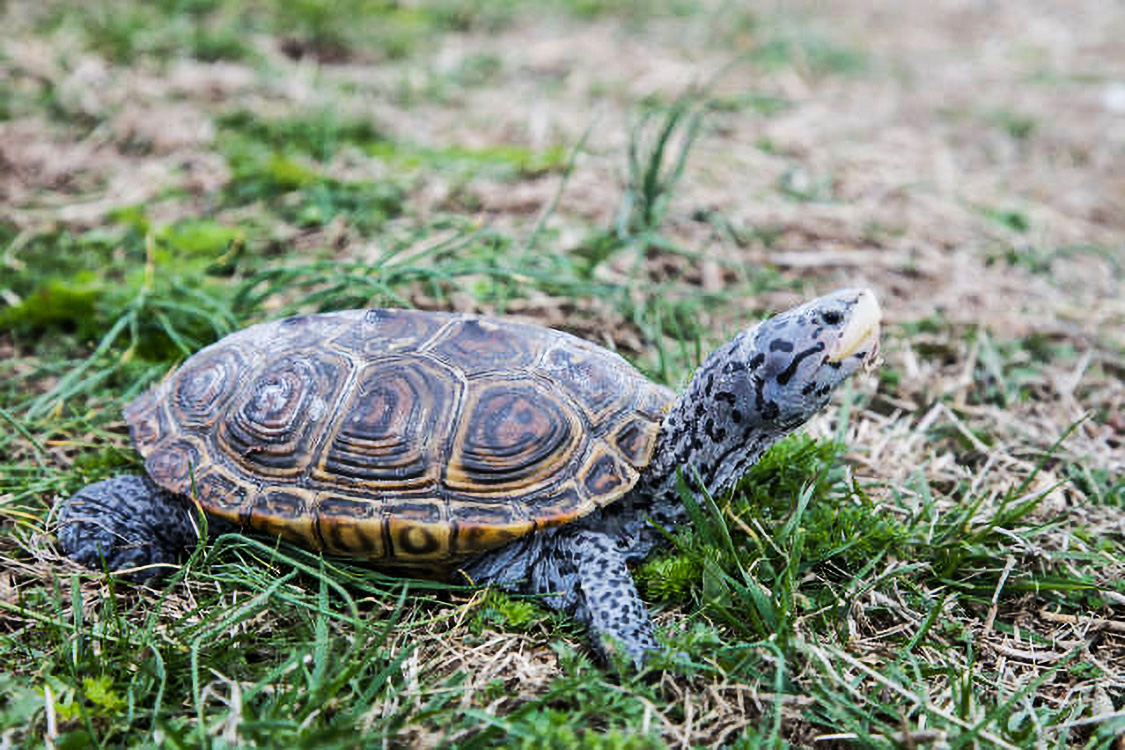Nature Notes: Diamonds in the Pond
by Terry McNamara
The diamondback terrapin (Malaclemys terrapin) that calls Fishers Island home is a rarely seen turtle treasured for its role in maintaining the health of its surrounding ecosystem. In the wild, terrapins are quick to flee and difficult to observe. Since 2018, live specimens have been photographed on Fishers Is- land on the bike path near Island Pond in early summer— probably attempting to nest.
Although sightings are rare, on a calm day an astute observer may sometimes see them basking on the surface of Island Pond to warm themselves and osmoregulate (balance internal salinity) or hunting in the channel leading to Beach Pond.
Unique appearance and habits:
The concentric rings on the terrapin’s carapace (hard upper shell) resemble the facets of a cut diamond, giving this precious creature its name. Another distinction of the diamondback terrapin is that it has webbed feet, rather than the flippers common among other turtles in the marine environment. Its skin is light and marked with dark patches unique to each individual. The white upper jaw gives it a “smile” that further enhances its charismatic appearance.
Diamondback terrapins are sexually dimorphic: they show a systematic difference in form between individuals of different sexes. A mature female’s carapace measures 10 inches, twice that of a mature male.
They are strong swimmers. After a brief period on the surface, they can remain submerged for three or more hours. Diamondbacks leave the water only to lay their eggs; locally, in June, diamondback females dig a nest in sandy substrate above the high tide line.
Diamondback terrapin. Photo courtesy of USFWS.
The diamondback terrapin is the only turtle in the United States that lives in brackish water. Research into their unique ability to live in fresh, brackish, and saltwater environments has brought to light some interesting behaviors. For example, to obtain fresh water, the terrapin will float on the salty surface with its head extended and mouth open to catch raindrops. They are also able to drink fresh water from the newly-fallen rain while it rests unmixed on the surface of a saline body of water.
Terrapins are ectothermic (cold-blooded), like all turtles, and they brumate (the reptilian equivalent of hibernation) through the winter. In late fall, when water temperatures drop below 59˚F, a terrapin takes its last breath of the year and slips beneath the surface to bury itself in muddy substrate. The turtle will reemerge in the spring, when the temperatures around it return to 55˚F, to forage and mate.
Strong jaws enable the carnivorous diamondback to feed upon aquatic snails, crabs, and small bivalves such as oysters, mussels, and clams. The turtles are one of the apex predators of brackish marshes and ponds, also eating carrion, fish, worms, and insects. Like the common snapping turtle in freshwater ponds, terrapins’ activities are key to maintaining the overall health of the brackish ponds they inhabit.
Turtle soup:
Diamondback terrapins, regarded as beautiful, are highly sought-after pets. The turtles are also, unfortunately, considered a delicacy food item for humans. As a result, terrapins were hunted almost to extinction in the 1900s.
While terrapins were a traditional food for Native Americans and colonial settlers, the popularity of turtle soup in the late 1800s to early 1900s caused their population to plummet. A combination of scarcity, the Prohibition era (sweet wine was a major turtle soup ingredient), and dire financial conditions reduced the demand for turtle soup, and terrapins were able to recover somewhat.
Future outlook:
Despite increased public awareness of these wonderful creatures, their future remains uncertain. Multiple threats imperil terrapins. Raccoons eat nesting females and are a major predator of diamondback eggs. Bycatch—incidental capture—in crab traps and especially in “ghost traps” (abandoned or lost traps) takes a large toll on local populations. The pet trade, automobile strikes on nesting females, and boat strikes also diminish terrapin numbers; a dead female with a propeller injury was found on South Beach.
More recently, scientists have raised hatchlings from eggs harvested from females killed by vehicles when attempting to reach nesting areas. Such hatchlings are often incubated and raised over the winter to give them a head start. Participation in these rescue and restoration projects has popularized the terrapin and brought attention to their tenuous situation.
Although every state but Louisiana prohibits commercial fishing for diamondback terrapins, a new threat to U.S. turtles is an ever-growing Asian market. The Diamondback Terrapin Working Group (dtwg.org) is coordinating an effort to stream- line the current state-by-state approach and to ensure the continued conservation of this unique turtle.
Remember to stay aware of not only diamondback terrapins, but also all our local snapping, box, painted, and spotted turtles as they move about in spring and early summer seeking suitable nesting areas! Avoid harming these sensitive species, and help them across the road if necessary. If you have questions, please call the Museum during open hours.


